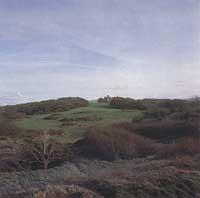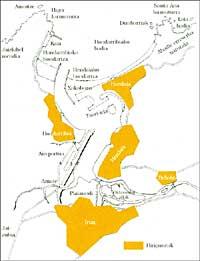Geological values of Abbadia
1993/08/01 Estonba Mintxero, Mikel | Bost, J. Iturria: Elhuyar aldizkaria
If Mr. Abbadia's biographical research attracts astronomers, philologists and scientists from other disciplines, one cannot despise what the environment he chose to build his castle generates in biologists and geologists. Therefore, this research could not be concluded without analyzing the riches offered by this environment.
Geology
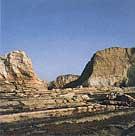
Tourists who first approach Hendaia beach soon observe the two rocks at the end of the beach and surrounded by water. However, these two rocks, known in Basque as Dunbarriak, are only the most spectacular indicators of an extensive environment of great geological importance that erosive agents have highlighted. From Hendaia to almost San Juan de Luz is thus the sea, and other erosive agents have highlighted the valuable marine cliff to understand the geological history of our region, in which perhaps the most surprising is the structure of strata that present the stones (as if they were leaves of a book). These strata have special interest in specific places where the stone structure “Flysch” appears, characterized by the alternation of hard / soft material.
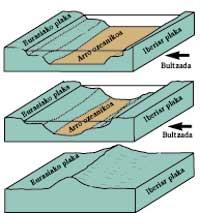
(Note: To see the photo well go to pdf).
To find the reason for these phenomena we must go back to time and return to the Upper Cretaceous that lasted from 100 million years to 65 million years. At that time, the current Pyrenees mountain range was the ocean basin that separated the Iberian peninsula from the Eurasian plate. As is the case today, the materials eroded by the rivers of the time accumulated on the marine platform and on the slope. When sediments are transported at ever lower speeds, the heaviest particles (limestones and sandstones) accumulate first, being the lightest ones (marls and clays) the last.
This alternating sedimentation provides Flysch with this form of layers. The transport of sediments at great distance through the marine canyons is due to the high speed currents generated under water, the turbidity currents. In Abbadia is quite abundant the presence of large and rounded stones called olistolitos, associated with this phenomenon.
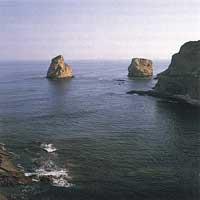
After a current of turbidity, this internal structuring obtained by sediments is known as the Bouma sequence, a geologist who studied these structures. However, those who have traveled the cliffs of Abbadia realize that these do not show the structure of the Flysch in all its extension, since in some places they are formed by detritic rocks called breaches. Analyzing the situation of these gaps, it has been concluded that its origin is the north edge of the ocean basin, demonstrating that the eroded rocks on this shore suffered a short transport.
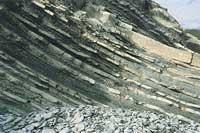
To all these phenomena we must add the fall of the seabed, called geological sinking, if we want to understand how these large deposits of sediments can occur. Along with these sediments the bodies of many animals of the time fell, whose hard parts, together with the remains of the movement of molluscs without annelids or shells, were fossilized once the following sedimentary layers were covered.
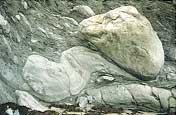
These fossils are very valuable both to test the theory mentioned, to know the type of life that existed then on the planet and to carry out chronological dating. Abbadia is rich in these fossils, and it is not difficult to find fossils of Ammonite (cephalopod molluscs), Globatruncula (microscopic foraminiferous used to date), or other animals on low tide routes.
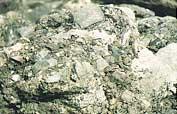
As for the pink color presented by the stones at the top of the cliff of Abbadia, specifically the sediments of the end of the second epoch and beginning of the third, it must be clarified that there is a high degree of oxidation of the sediments.
But why are these stones so rusty? The answer geologists have sought to this question is that, both by the distribution of tectonic plates and by the changes in the axial tilt of the Earth, the climate of this region was similar to that of the present tropics.
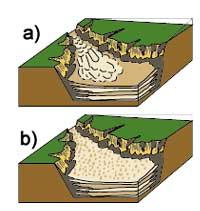
Entering the elderly, which lasted from 65 million years to 2 million years, the uprising of the Pyrenees started in the Eastern Cretaceous reached the West, and this area was also above sea level. The reason for the rise of the Pyrenees should be sought in the movement of the Iberian plate. Taking into account the theory of plate tectonics, in the Triassic era the Iberian peninsula was united from present-day Britain to the plate of Eurasia and from the south to the African plate.
In the Jurassic, moving the African plate eastward, he moved the Iberian plate southward, away from present-day Britain. This process lasted until the Upper Cretaceous, when the opposite phenomenon occurred. At that time the African plate pushed the Iberian against that of Eurasia, which caused the uprising of the Pyrenees. Consequently, the sea became the Pyrenean mountain range, leaving the erosive agents the stones that had until then been submerged.
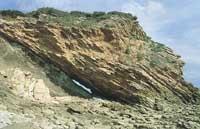
Due to this survey, the sediment layers were broken with the occurrence of faults. These failures are easily recognizable as the places where they appear:
- On the one hand, the alignment of the strata appears broken, where thin layers of calcite frequently appear (crystallized calcium carbonate due to increased friction temperature).
- On the other hand, if because of these failures the compartments have fallen, tectonized regions appear that present a structure of decomposed strata and large amounts of calcite. These regions, due to the changes that the rock has suffered due to friction, become more aggressive for erosive agents, appearing rocks like the Dunbarrias.
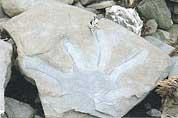
Once the Pyrenees were lifted, in this region geological phenomena took a turn of l80 degrees, from being a place of sedimentation to an erosive place, and these newly created mountains began to receive the influence of erosive agents.
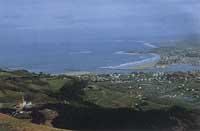
One of the most remarkable factors of these is the change produced by glaciations on the coastline. During glaciations, huge amounts of water were frozen during glaciers. As a result, the sea level receded. In interglacial times, however, the ice melted, increasing the sea level. In glacial times it has been calculated that our coast was located 13 kilometers later, since the water level was between 100 and 120 meters below the current one.
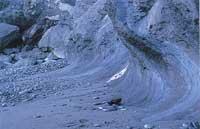
A reliable witness to these changes in sea level are the so-called “quetas” that have caused so many shipwrecks in front of Abbadia, indicators of coastal erosion during glacial periods.
Glaciations have always attracted scientists, so numerous hypotheses have been created to resolve the phenomenon. It is recognized that at present they are a consequence of different factors. It should be noted:
- Natural effects of other planets.
- Changes in solar activity.
- Earth orbit modifications.
- Changes in the Earth-Sun distance.
- Accuracy of equinoxes.
- Changes in the tilt of the earth's axis.
- Changes in elliptical eccentricity.
- Volcanic activity.
- Position changes to continental poles due to plate movement.
The following scheme can help to understand the phenomenon of glaciations:
Modification of astronomical parameters ØDovariation ofsolar
energy temperature and low atmosphere
due to ØModifications Climatic or interglacial
glaciations
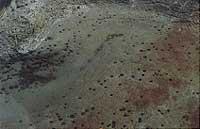
In the last 2 million years there have been five glaciations and glaciations. From the oldest, the names given to the glaciations are: Donau, Günz, Mindel, Riss and Würm.
We are currently in the post-glacial period of Würm. And while the current sea level is higher, erosive agents continue to attack the coastline. The most violent consequences are waves.
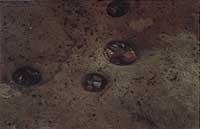
Because of them large gaps open at the base of the cliffs. To this is added the chemical wear produced by rain in the limestone at the top of the cliffs, so the cliffs fall. In addition, as a consequence of the fall of the cliffs, the pieces of rock that remain at the base of the same increase this phenomenon, since the waves throw these stones against the rock.
As a sign of this retreat, the sheepfold known as an abrasion platform appears at the base of the cliff, which is usually visible only in the basins.
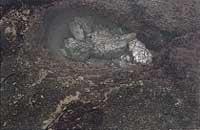
To conclude this small geological study of Abbadia, we refer to a special type of erosion caused by different living beings that inhabit this abrasion platform. That is, some perforating lamelibrankios (Lithodoma sp.) Once the holes opened in these limestone layers have become empty, the remains and small stones brought by the waves expand them, giving way to larger stones. This whole process gives rise to large holes that offer the necessary conditions for other intertidal living beings to live.
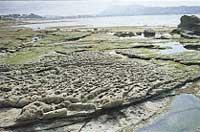
To those who after reading the article you are encouraged to approach Abbadia, after enjoying the beauty of the environment, we recommend to devote a little time to the rich geology of these cliffs, stones that demonstrate to the man that it is only the last “screw” of a giant mechanism that remains out of its time scale. Perhaps the radical change that is provoking our excessive ambition on earth, thinking that millions of years from now will become rocky strata of several centimeters, in addition to helping to curb our pride, leads us to reflect on our attitude towards nature.

Gai honi buruzko eduki gehiago
Elhuyarrek garatutako teknologia



